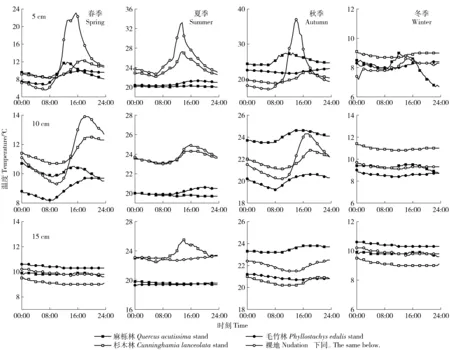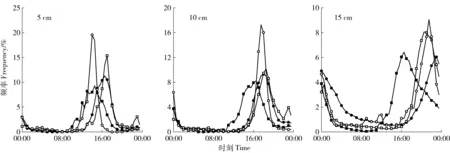长三角区典型林分浅层土壤温度变化特征
2017-07-05杨丹孙永涛庄家尧张金池葛波凡国华
杨丹,孙永涛,庄家尧†,张金池,葛波,凡国华
(1.南京林业大学水土保持与生态修复实验室,210037,南京; 2.国家林业局华东林业调查规划设计院,310016,杭州)
长三角区典型林分浅层土壤温度变化特征
杨丹1,孙永涛2,庄家尧1†,张金池1,葛波1,凡国华1
(1.南京林业大学水土保持与生态修复实验室,210037,南京; 2.国家林业局华东林业调查规划设计院,310016,杭州)
为客观反映长三角区典型林分下浅层土壤温度变化特征,揭示森林调节浅层土壤温度的作用。使用土壤温度传感器EM50对南京铜山麻栎(Quercusacutissima)林地、毛竹(Phyllostachysedulis)林地及杉木(Cunninghamialanceolata)林地浅层(5 cm、10 cm、15 cm)土壤温度于2012年6月至2013年5月进行长期监测,以裸地为对照,分析以上3种林分内浅层土壤温度变化特征。结果表明:林内土壤温度日变化及年变化幅度均较裸地小,其中日较差从大到小依次为:裸地、杉木林、毛竹林、麻栎林;年较差从大到小依次为:裸地、杉木林、麻栎林、毛竹林;森林具有夏、秋季降低林内土壤温度的作用,其中,毛竹林降低土壤温度效果最好(约降低1~3 ℃),冬、春季具有提高林内土壤温度的作用,其中,杉木林提高土壤温度效果最好(约提高0.1~1 ℃);森林能降低年均土壤温度,其中毛竹林约降低1~2 ℃,麻栎林与杉木林约降低0.5~1.5 ℃;森林能滞后林内土壤温度日最值出现的时刻,其中杉木林滞后时间最长,其次为毛竹林,最后为麻栎林;林分能降低土壤温度日最高温,春、冬季可提高土壤温度日最低温,其中麻栎林降低土壤温度日最高温作用最好,春、冬季,杉木林与麻栎林提高土壤温度日最低温作用最好。毛竹林与麻栎林土壤温度日较差及年较差均要小于杉木林,毛竹林的夏秋季降温和冬春季升温的能力要优于麻栎林与杉木林,杉木林滞后土壤温度出现时刻的能力要优于毛竹林与麻栎林,麻栎林降低土壤温度最高温与升高土壤温度最低温的能力要优于毛竹林与杉木林。该结论可为林内土壤环境保护及树种选择提供参考依据。
土壤温度; 浅层土壤; 麻栎林; 毛竹林; 杉木林
土壤温度作为地表主要物理参量之一,是土壤作用于植物的重要指标。土壤温度的时空动态直接受气温、降水、土壤含水量、土壤导热率、土壤热容量和土壤热扩散率等气候和土壤环境的影响[1],进一步影响森林土壤微生物活性、枯落物分解率及土壤呼吸[2-5],从而决定土壤资源质量高低,最终影响植物生长、发育、繁殖和分布,群落动态、结构,以及生态系统的结构与功能[6-8]。长三角区是受北亚热带季风气候影响的中国第一大经济发达区,夏季酷热的气候对合理配置人工植被群落提出更高的要求。森林通过吸收、反射太阳辐射,能减少林内土壤温度波动幅度及降低林内土壤温度,为植物创造更适宜生长的土壤环境[9]。近年来国内学者对林内土壤温度变化特征研究较多:Corumluoglu等[10]通过3.5D地理信息系统模型评估了土耳其土壤温度对全球变暖的影响,得出土壤温度是全球变暖的主要影响因子;Savva等[11]通过对不同土地利用类型及不同植被覆盖下城市生态系统中的土壤温度的研究,开发了2种植被和2种土地利用类型下的土壤温度预测模型;李猛等[12]通过对小兴安岭红松阔叶混交林生长季内林隙浅层土壤温度的连续观测,分析了夏季空旷地、林隙与林内浅层土壤温度的空间异质性,得出夏季空旷地浅层土壤温度始终高于林内;杜尧东等[13]研究广州地区蔬菜田土壤温度特征,并建立以气温为自变量的各深度土壤温度预报模型;张一平等[14]对哀牢山亚热带常绿阔叶林进行人工模拟增温,研究土壤温度时空分布及对模拟增温的响应;付强等[15]对北方高寒区典型城市哈尔滨不同覆盖下土壤温度进行差异性分析;朱宾宾等[16]以大兴安岭北部白桦次生林为研究对象,研究林下积雪温度及不同土层温度分布特征。而对长三角区典型林分土壤温度变化特征的研究很少。现国内外对土壤温度的研究大多分为2种,一为土壤温度的预测[11,17-18],二为探讨森林调节林内土壤温度的效应[19],在森林调节林内土壤温度效应方面大多探讨的也是森林调节林内土壤温度的作用,在研究森林滞后土壤温度方面上还较少[18]。
笔者根据长三角区南京市铜山土壤温度系统资料,以日、季节、年等不同尺度,对南京市铜山典型林地内各土层(5、10和15 cm)土壤温度进行统计分析与比较,旨在揭示森林调节土壤温度的作用,并为林内土壤坏境保护、人工植被群落配置、林业规划及树种选择提供参考依据。
1 研究区概况
试验区位于长三角区西部南京市国营东善桥林场铜山分场(E 118°50′~118°52′,N 31°35′~31°39′),属北亚热带季风气候区,年平均气温15.1 ℃,无霜期229 d,年日照时间199 h,区内气候温和湿润,四季分明,水热资源比较丰富,生长季长。年平均降水量1 100 mm,地形为苏南丘陵,森林类型以麻栎林(Quercusacutissima)、杉木(Cunninghamialanceolata)、毛竹(Phyllostachysedulis)为主,为长三角地区典型林分,土壤类型为黄棕壤,坡向均为东北向(NE),土壤厚度为60 cm左右,60 cm以下为砂岩风化母质层,海拔38~388 m,地下水位位于10.0 m以下。土壤温度测量试验地点选择考虑不受林缘和林窗影响的麻栎林地、毛竹林地、杉木林地(表1)与裸地。

表1 林分基本概况Tab.1 Basic information of stands
2 材料与方法
选择土壤与光照条件一致的试验点,试验点设置考虑位于数株植物组成的多边形的中心,且EM50探头附近10 cm内无直径0.5 cm以上树根分布,监测各林分内各层土壤温度,每个土壤深度(5、10和15 cm)共设置2个观测点观测土壤温度,并在试验点地表覆盖2 cm厚度凋落物。
在各林分试验点内设置EM50探头(产自美国),于2012年6月至2013年5月连续监测麻栎林地、毛竹林地、杉木林地与裸地土壤温度,每30 min记录1次数据,四季的划分采用气候学统计法[20]以3至5月为春季,6至8月为夏季,9至11月为秋季,12至次年2月为冬季。取3月14日、6月13日、9月15日和12月11日(均为晴天)数据分别代表春、夏、秋、冬各季土壤温度的日变化;取2012年6月至2013年5月每月瞬时数据的平均值作为该月温度值,进行土壤温度季节变化分析;取2012年6月至2013年5月瞬时数据做土壤温度年均值统计,分析各林分降低土壤温度的效应。对各土层土壤温度每日出现最值时刻的频率进行统计分析,并对各林分与裸地内各土层每月土壤温度最高温与最低温进行比较分析。
利用Microsoft Excel 2007软件进行数据处理及制作表格,Origin 8.5绘图软件进行数据分析及绘图,采用SPSS 19.0进行相关的统计与分析,采用最小显著差法(LSD) 在0.05水平确定各个平均值之间的差异显著性。
3 结果与分析
3.1 典型林分浅层土壤温度日变化
如图1所示,各林分土壤温度日变化均呈正弦函数变化曲线变化,从00:00开始,太阳辐射还未出现,土壤温度逐渐下降,在04:00至08:00达到最小值,随着太阳辐射的出现并逐渐上升,土壤温度也逐渐升温,并于12:00至18:00,各林分土壤温度逐渐达到高峰,再随太阳辐射的下降土壤温度也随之下降,每个林分土壤温度达到峰值与谷值的时间不一致;表层土壤土壤温度日变化幅度大,随着土壤深度的增加,土壤温度受太阳辐射及气温的影响变小,土壤温度日变化幅度逐渐减小;春、夏、秋季,土壤温度日变化幅度较冬季大。整体来说,裸地土壤温度日变化幅度最大,其次为杉木林,毛竹林与麻栎林土壤温度日变化幅度相对较小。
3.2 典型林分浅层土壤温度季节变化
如图2所示,各林分月均土壤温度变化趋势均
一致,为单峰型,均在7月份达到峰值,1月份达到谷值。计算各林分土壤温度季均值(表2),在春季,毛竹林能提高土壤温度(0.1~0.6 ℃),麻栎林能降低土壤温度(0.1~0.5 ℃),杉木林则效果相对不明显;在夏季,所有林分均有降低土壤温度的作用,其中毛竹林约降低土壤温度1~2 ℃,麻栎林1~3 ℃,杉木林1.5~3 ℃;在秋季,所有林分具有降低土壤温度的作用,毛竹林能降低土壤温度(2~3 ℃),麻栎林与杉木林则效果不明显(0~1 ℃);在冬季,杉木林能提高土壤温度(0.1~1 ℃),毛竹林与麻栎林均能降低土壤温度,其中毛竹林降低1~2 ℃土壤温度,麻栎林0.1~0.5 ℃。

图1 不同季节土壤温度日变化Fig.1 Diurnal change of soil temperature in different seasons at depth of 5 cm, 10 cm and 15 cm

图2 月均土壤温度变化Fig.2 Monthly variation of soil temperature

季节Season土层Layer/cm麻栎林Quercusacutissimastand毛竹林Phyllostachyedulisstand杉木林Cunninghamialanceolatastand裸地Nudation583±31a90±30b84±28a85±43c春季Spring1087±29a91±28b100±26c90±36b1588±24a98±22b77±23c92±34d5192±25a193±26a187±38b215±23c夏季Summer10197±31a188±25b190±35b205±22c15188±28a181±21b174±46c206±18d5244±18a232±21b246±15a263±16c秋季Autumn10252±16a229±17b252±14a253±15a15244±11a224±07b241±17c252±14d5125±57a115±53b133±57c129±67c冬季Winter10133±49a119±52b146±49c138±52d15137±46a129±44b139±49a138±56a
注:同行不同小写字母分别表示在P<0.05水平上差异达显著水平(LSD)。Note: Different lowercase letters in the same row mean significantly different at 5% level of probability (LSD).下同。The same below.
3.3 典型林分浅层土壤温度年统计
对各林分土壤温度年均值及年较差进行统计分析(表3),5 cm土层土壤温度年变化幅度最大,随着土壤深度的增加,变化幅度逐渐减小;裸地土壤温度年变化幅度最大,其次为杉木林、麻栎林,最后为毛竹林。各林分土壤温度年均值大小依次为:裸地、麻栎林、杉木林、毛竹林。表明,林地能降低土壤温度年均值,其中,毛竹林效果最好,能降低土壤温度年均值1~2 ℃,麻栎林与杉木林效果一般,降低土壤年均值0.5~1.5 ℃。

表3 土壤温度年均值Tab.3 Annual average of soil temperature
各林分土壤温度最高温及最低温出现时刻进行频率统计分析(图3、图4和表4)。表明:5 cm土层中,裸地表层土壤温度出现最值的时间最早,其次为麻栎林、毛竹林、杉木林,麻栎林约滞后30 min,毛竹林约150 min,杉木林约180 min;10 cm土层中,麻栎林出现土壤温度最值时间比裸地早,60~120 min,毛竹林与杉木林滞后土壤温度最低温效果不明显,毛竹林滞后最高温出现时间为30 min,杉木林为60 min;15 cm土层中,麻栎林出现土壤温度最值时间比裸地早,270~490 min,杉木林与裸地出现土壤温度最高温与最低温的时刻大致一致,毛竹林有滞后土壤温度出现最值的时间,约30 min。随着土壤深度的增加,林分滞后土壤温度效果越不明显,土壤温度传播速度跟土壤含水量、有机质含量及根系含量等介质有关,各林分土壤环境均不相同。

图3 土壤温度最高温出现时刻频率分布Fig.3 Frequency distribution of occurring time of the maximum soil temperature

图4 土壤温度最低温出现时刻频率分布Fig.4 Frequency distribution of occurring time of the minimum soil temperature

最高温与最低温Maximum/minimumtemperature土层Layer/cm麻栎Quercusacutissimastand毛竹Phyllostachysedulisstand杉木Cunninghamialanceolatastand裸地Nudation514:3016:3017:0014:00最高温Maximumtemperature1016:3018:0018:3017:301516:3023:0020:3021:0056:007:008:005:30最低温Minimumtemperature106:008:009:009:00157:0012:3011:3011:30
极值分析计算得出各林分与裸地月土壤温度最高温与最低温之差(图5和图6),各林分土壤温度最高温基本高于裸地,6—翌年1月,5 cm土层各林分与裸地土壤温度最高温差异最显著,约为6~21 ℃,总体来说,麻栎林与裸地土壤温度最高温之差最高,毛竹林及杉木林与裸地土壤温度之差差异不显著。冬、春季,杉木林及麻栎林土壤温度最低温基本高于裸地,夏、秋季,基本低于裸地,毛竹林土壤温度最低温基本全年低于裸地。表明林分有降低土壤温度最高温的作用,麻栎林作用最为显著,冷季杉木林与麻栎林有升高土壤温度最低温的作用。

图5 各林分与裸地月土壤温度最高温之差Fig.5 Difference of maximum soil temperature between stands and nudation

图6 各林分与裸地月土壤温度最低温之差Fig.6 Difference of minimum soil temperature between stands and nudation
4 结论与讨论
通过对长三角区典型林分下浅层土壤温度变化特征分析得出:
1)森林能减小土壤温度日变化及年变化幅度,其中杉木林土壤温度变化幅度中等,毛竹林与麻栎林土壤温度变化幅度较小。这与吴湘雄等[9]研究结果一致,林内由于林冠层的遮挡,以及枯枝凋落物对地表的遮盖,使林内土壤温度振幅较裸地小[9]。说明毛竹林与麻栎林能使土壤温度变化处于一个较稳定的状态,更适宜林内生物生长活动,杉木林效果一般。
2)森林在夏、秋季均有降低土壤温度的作用,冬、春季,除杉木林能升高土壤温度外,毛竹林与麻栎林均降低土壤温度,这与常晓丽等[21]研究结果略不同,在本研究中,森林在冬、春季升高土壤温度的效果不明显,分析其原因,可能由于研究区所属气候条件不一致。夏秋季,毛竹林降低土壤温度效果最好,冬季,杉木林升高土壤温度效果最好,春季,毛竹林升高土壤温度效果最好。整体来说,毛竹林暖季降温冷季升温效果最好,其次为杉木林,最后为麻栎林。
3)森林能降低林内土壤温度年均值,各林分土壤温度年均值大小依次为:裸地、麻栎林、杉木林、毛竹林,其中,毛竹林效果最好,能降低土壤温度年均值约1~2 ℃,麻栎林与杉木林效果相对一般,降低土壤年均值约0.5~1.5 ℃。这与孙双峰等[22]研究结果一致。
4)森林能滞后林内土壤温度最值出现的时刻,其中杉木林滞后效果最好,其次为毛竹林,最后为麻栎林,这与吴力立[23]研究结果一致,林内由于冠层的阻挡作用,使林内土壤温度变化较为平缓,使土壤温度增温慢,散热也慢。
5)林分能降低土壤温度最高温,春、冬季可升高土壤温度最低温,这与吴力立[23]研究结果一致,林内冠层对太阳辐射的削减,使林内土壤温度最高温低于裸地,由于枝叶气流的遮挡,减少林内土壤温度向外传递,使林内土壤温度最低温高于裸地。麻栎林降低土壤温度最高温的作用最好,春、冬季,杉木林与麻栎林提高土壤温度最低温的作用最好。
综上所述,本文所研究的3个林分,毛竹林与麻栎林土壤温度变化幅度较杉木林小,毛竹林夏秋季降温冬春季的升温的能力要优于麻栎林与杉木林,毛竹林降低土壤温度年均温的效果要优于麻栎林与杉木林,杉木林滞后土壤温度出现时刻的能力要优于毛竹林与麻栎林,麻栎林降低土壤温度最高温与升高土壤温度最低温的能力要优于毛竹林与杉木林。
[1] 王淼,韩士杰,王跃思.影响阔叶红松林土壤CO2排放的主要因素[J].生态学杂志,2004,23(5):24. WANG Miao, HAN Shijie, WANG Yuesi.Important factors controlling CO2emission rates from forest soil[J]. Chinese Journal of Ecology,2004,23(5):24.
[2] 刘春霞,王玉杰,王云琦,等.重庆缙云山3种林型土壤呼吸及其影响因子[J].土壤通报,2013,44(3):587. LIU Chunxia, WANG Yujie, WANG Yunqi,et al.Soil respiration and impact factors of 3 forest types in Jinyun mountain of Chongqing[J]. Chinese Journal of Soil Science, 2013, 44(3):587.
[3] GUAN Dexin, WU Jiabing, YU Guirui, et al.Meteorological control on CO2flux above broad-leaved Korean pine mixed forest in Changbai Mountains[J]. Science in China: Series D Earth Sciences, 2005, 48(S1):116.
[4] GUAN Dexin, WU Jiabing, ZHAO Xiaosong,et al. Annual CO2fluxes over an old, temperate mixed forest in north eastern China[J]. Agricultural and Forest Meteorology, 2006, 137(3):138.
[5] WU Jiabing, GUAN Dwxin, WANG Miao, et al. Year-round soil and ecosystem respiration in a temperate broad-leaved Korean pine forest[J]. Forest Ecology and Management, 2006, 223(1):35.
[6] 周邦社,杨新兵.植被和坡向对土壤温度与土壤热通量变化的影响[J].河北农业大学学报, 2001, 34(2):80. ZHOU Bangshe, YANG Xinbing.Effect of vegetation and slope on soil temperature and soil heat flux[J]. Journal of Agricultural University of Hebei, 2001, 34(2):80.
[7] KÖRNER C, PAULSEN J. A worldwide study of high altitude treeline temperatures[J]. Journal of Biogeography, 2004, 31(5):713.
[8] GEHRIG-FASEL J, GUISAN A, ZIMMERMANN N E. Evaluating thermal treeline indicators based on air and soil temperature using an air-to-soil temperature transfer model[J]. Ecological Modelling, 2008, 213(3/4):345.
[9] 吴湘雄,康文星,傅强,等. 樟树人工林内和林内空地土壤温度分布的研究[J].中南林业科技大学学报,2012, 32(5):113. WU Xiangxiong, KANG Wenxing, FU Qiang, et al.Studies on soil temperature distribution of camphorplantations and forest clearance area[J]. Journal of Central South University of Forestry & Technology, 2012, 32(5):113.
[10] CORUMLUOGLU O, AYDIN M E, ASRI I, et al. The evaluation of global warming’s effects on soil temperature of Turkey by 3.5D geographical information system models[C]. International Multidisciplinary Scientific Geoconference-SGEM, 2010:285.
[11] SAVVA Y, SZLAVECZ K, POUYAT R V, et al. Effects of land use and vegetation cover on soil temperature in an urban ecosystem[J].Soil Science Society of America Journal, 2010, 74(2):469.
[12] 李猛,刘洋,段文标.红松阔叶混交林林隙浅层土壤温度的异质性[J].生态学杂志,2013,32(2):319. LI Meng, LIU Yang, DUAN Wenbiao.Heterogeneity of shallow soil temperature in the forest gaps ofPinuskoraiensis-dominated broad leaved mixed forest[J]. Chinese Journal of Ecology, 2013, 32(2):319.
[13] 杜尧东,刘锦銮,何健.广州地区蔬菜田土壤温度变化特征及其预报模型研究[J].生态学杂志,2005,24(9):1021. DU Yaodong, LIU Jinluan, HE Jian.Characteristics of soil temperature dynamics in vegetable field and its forecasting model in Guangzhou[J]. Chinese Journal of Ecology, 2005, 24(9):1021.
[14] 张一平,武传胜,梁乃申,等.哀牢山亚热带常绿阔叶林土壤温度时空分布对模拟增温的响应[J].生态学杂志,2015, 34(2):347. ZHANG Yiping, WU Chuansheng, LIANG Naishen, et al.The response of soil temperature to experimental warming in a subtropical ever green broad-leaved forest in Ailao Mountains, Yunnan, SW China[J]. Chinese Journal of Ecology, 2015, 34(2):347.
[15] 付强,马梓奡,李天霄,等.北方高寒区不同覆盖条件下土壤温度差异性分析[J].农业机械学报,2014,45(12):152. FU Qiang, MA Ziao, LI Tianxiao, et al.Variability of soil temperature under different coverage conditions in alpine region of China[J]. Transactions of the Chinese Society of Agricultural Machinery, 2014, 45(12):152.
[16] 朱宾宾,满秀玲,王树力,等.大兴安岭北部白桦次生林林内积雪及浅层土壤温度分布特征[J].东北林业大学学报,2015, 43(12):36. ZHU Binbin, MAN Xiuling, WANG Shuli, et al.Characteristics of temperature in snow-cover and shallow-soil inBetulaplatyphyllasecondary forests in the northern Daxing’an Mountains[J]. Journal of Northeast Forestry University, 2015, 43(12):36.
[17] HORTON B, CORKREY R. A weighted coefficient model for estimation of Australian daily soil temperature at depths of 5 cm to 100 cm based on air temperature and rainfall[J].Soil Research,2011, 49(4):305.
[18] 侯建花,李桥,徐小军,等.利用气温进行统计回归预测土温[J].浙江林业科技,2015,35(5):55. HOU Jianhua, LI Qiao, XU Xiaojun, et al. Prediction model for soil temperature by statistical regression of air temperature[J]. Journal of Zhejiang Forestry Science and Technology, 2015, 35(5):55.
[19] 孙金伟,吴家兵,关德新,等.森林与空旷地空气温湿度及土壤温度的长期对比研究[J].生态学杂志,2011, 30(12):2685. SUN Jinwei, WU Jiabing, GUAN Dexin, et al.A long-term observation on the air temperature, relative humidity, and soil temperaturein a mixed forest and its adjacent open site in Changbai Mountains of Northeast China[J]. Chinese Journal ofEcology, 2011, 30(12):2685.
[20] 么枕生.气候统计学基础[M].北京:科学出版社,1984. ME Zhensheng. Fundamentals of climatological statistics[M]. Beijing: Science Press, 1984:534.
[21] 常晓丽,金会军,于少鹏.大兴安岭林区不同植被对冻土地温的影响[J].生态学报,2011,31(18):5138. CHANG Xiaoli, JIN Huijun, YU Shaopeng.Influence of vegetation on frozen ground temperatures the forested area in the Daxing’anling Mountains, northeastern China[J]. Acta Ecologica Sinica, 2011, 31(18):5138.
[22] 孙双峰,田大伦,康文星.第二代杉木人工林土壤温度的研究[J].中南林学院学报,2000, 20(1):22. SUN Shuangfeng, TIAN Dalun, KANG Wenxin.Study of the soil temperature of second generation Chinese fir stand[J].Journal of Central South Forestry University, 2000, 20(1):22.
[23] 吴力立.城市森林土壤温度场的特征[J].南京林业大学学报(自然科学版),2003,27(1):21. WU Lili.A study on the thermal field of the soil in urban forest[J]. Journal of Nanjing Forestry University(Natural Sciences Edition), 2003, 27(1):21.
Variation characteristics of shallow-soil temperature undertypical stands in the Yangtze River Delta
YANG Dan1, SUN Yongtao2,ZHUANG Jiayao1, ZHANG Jinchi1, GE Bo1, FAN Guohua1
(1.Soil and Water Conservation and Ecological Restoration Laboratory of Nanjing Forestry University,210037, Nanjing, China;2. East China Forest Inventory and Planning of State Forestry Administration,310016, Hangzhou, China)
[Background] The soil temperature directly determines the quality of soil resources, and affects plant’s growth, development, reproduction and distribution. As the largest economic developed area in China, the hot summer in the Yangtze River Delta demands high requirements for the rational allocation of artificial vegetation communities. This work aims to understand the changes of temperature of shallow-soil under typical stands in the Yangtze River Delta, and to reveal the effects of forest on regulating temperature of shallow-soil. [Methods] The soil temperature sensor EM50 was used to conduct long-term monitoring, from June 2012 to May 2013, on temperature of shallow-soil (5 cm, 10 cm, and 15 cm) ofQuercusacutissimastand,Phyllostachysedulisstand andCunninghamialanceolatastand in Tongshan of Nanjing. With nudaton as the control, the temperature variation characteristics of shallow-soil under three stands were analyzed by Microsoft Excel 2007, Origin 8.5, SPSS 19.0 and LSD. [Results] The diurnal variation and annual variation of soil temperature under forest was smaller than that in nudation. The diurnal range of soil temperature was in descending order of nudation,C.lanceolatastand,P.edulisstand andQ.acutissimastand and the annual variation range was in descending order of nudation,C.lanceolatastand,Q.acutissimastand andP.edulisstand. The forest presented the effect of decreasing the soil temperature in summer and autumn, moreover,P.edulisstand(about 1-3 ℃)showed the best effect of reducing soil temperature. The forest had the function of increasing soil temperature in winter and spring, moreover,C.lanceolatastand(about 0.1-1 ℃)showed the strongest effect of increasing soil temperature. The forest caused the decrease of the annual average temperature, andP.edulisstand decreased the annual average temperature about 1-2 ℃,C.lanceolatastand andQ.acutissimastand about 0.5-1.5 ℃, respectively. The forest lagged the time of the daily maximum and minimum temperature of soil, and the lagging effect was descending in order ofC.lanceolatastand,P.edulisstand andQ.acutissimastand. The highest temperature of soil temperature was lowered by forest and the lowest temperature of soil temperature rose in spring and winter. The effect of reducing daily highest temperature of soil temperature was the most significant underQ.acutissimastand. In the spring and winter,Q.acutissimastand andC.lanceolataacted as the best role in increasing daily lowest soil temperature. [Conclusions] The diurnal range and annual range of soil temperature under bothQ.acutissimastand andP.edulisstand was smaller than that underC.lanceolatastand. For the ability of reducing soil temperature in summer and autumn and raising the temperature in winter and spring, theP.edulisstand was better thanQ.acutissimastand andC.lanceolatastand. For the ability of lagging the time of the maximum and minimum temperature of soil, theC.lanceolatastand was better thanP.edulisstand andQ.acutissimastand. For the ability of reducing the maximum temperature of soil and raising the lowest temperature of soil,Q.acutissimastand was better thanP.edulisstand andC.lanceolatastand. This conclusion can provide reference for soil environment protection and tree species selection.
soil temperature; shallow-soil;Quercusacutissimastand;Phyllostachysedulisstand;Cunninghamialanceolatastand
2016-12-14
2017-01-11
杨丹(1994—),女,硕士研究生。主要研究方向:森林水文与水土保持。E-mail:332090694@qq.com
†通信作者简介: 庄家尧(1969—),男,博士,副教授。主要研究方向:森林水文与水土保持。E-mail:nlzjiayao@njfu.edu.cn
S714.2
A
2096-2673(2017)03-0065-09
10.16843/j.sswc.2017.03.009
项目名称: 江苏省高校自然科学研究重大项目“基于水量平衡的南京城郊植被水源涵养机制研究项目”(16KJA220003)
